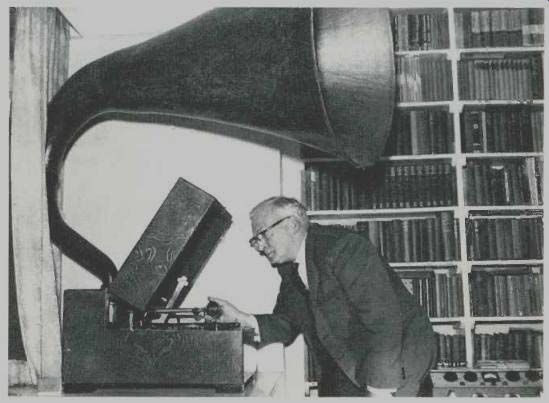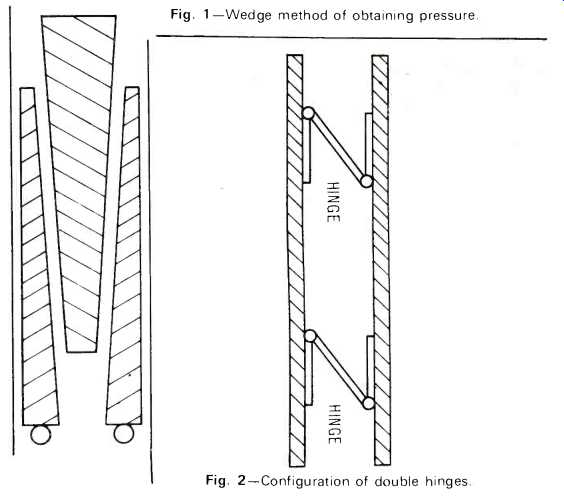

above: Percy Wilson is one of the most respected pioneers in this
industry. He was Technical Advisor to The Gramophone from 1924 to 1938 & Technical
Editor 1953-1968. He is the author of the famous "Gramophone Handbook" which
is now being revised.
NOT withstanding all the gadgetry that has been produced commercially, there are still many complaints that the records the public buys soon develop serious faults--pops, crackles, and warping, and may right from the beginning have eccentric holes. This even applies to records bought from specialist firms who guarantee that the records they sell will be un-played and delivered in sealed envelopes.
There is little one can do about eccentric records--"swingers" we used to call them. Fortunately they are much rarer than they used to be.
Warping can be cured. The method is a little troublesome, but it is certainly worth while for anyone who really values his record collection. Two sheets of plate glass about 12 1/2 inches square are needed. (Actually I use two circular sheets taken from the ports of old aircraft.) One of the surfaces of each of these should be scrupulously cleaned and polished. The record is then placed between the two and the assembly placed on top of a warm stove. If the glass sheets are thick, it is unlikely that the record will get too hot, though a temperature above about 150°F, at the record surface should be avoided. On the top of the upper glass a heavy weight can be placed. I used to use three volumes of the Encyclopedia Britannica. In about 12 hours the record can be removed and tested, on a turntable of course, for warping. In some cases the treatment may have to be repeated for a longer time.
The "pop and crackle" problem is more difficult. I have spent the best part of 10 years in research and have written two papers to the Audio Engineering Society describing my conclusions. Unfortunately, these indicated a remedy which was most expensive, since it demanded first of all an efficient method of wet cleaning and then a means of suction of the deposits from the record surface. I constructed about half a dozen pieces of apparatus to secure the result. My present system could not be marketed for less than about 250 British Pounds ($600), which as Euclid said, is absurd.*
[*250 Pounds or $600 is a lot of money however you look at it, and we will be pleased to print details of the cheaper machine as soon as available. -Ed. ]
So I concluded that one must search for a simpler and less expensive procedure for avoiding the contamination. I think I have found it, and I am arranging with Metrosound to market the appropriate (and quite inexpensive apparatus.
First of all, though, may I explain the problem? Years ago, when Cecil Watts devised the Dust-Bug, and I applauded it in my Gramophone Handbook (now out of print), and Julian Herbage repeated my approbation in his Sunday morning broadcast on Music Magazine, Cecil wrote to me saying,
"What have you done to me? I have 5,000 letters to answer and no means to doing it."
But he proceeded to make a commercial device out of the Dust-Bug.All praise to him. He himself described it in his contribution to Gilbert Brigg's Audio Biographies. His device dealt effectively with all the loose deposits which bedevil the records by electrostatic attraction. These are mostly fluff, but there are also fine particles of grit. These must be removed, and the Dust-Bug technique was aimed at minimizing the electrostatic discharge and removing the particles that broke through.
Our research, however, showed that there was a more subtle problem. The rotating record creates a sort of vortex which sucks down the air above the record, and then disperses it over the surface and shoots it over the edge. You can easily test this for yourself, as I demonstrated at the A.E.S. Fall convention in New York in 1964, by getting a piece of plastic tubing and inserting a metal tube about six inches long at the end (as a sort of cooling device). Then, holding this metal tube about six inches above the spindle of the rotating turntable, you fill your mouth with tobacco smoke and slowly blow it through the plastic tubing.
You will find that the smoke descends onto the turntable in a sort of exponential curve, and then shoots rapidly over the edge. A most intriguing picture! This vortex, of course, drags down any minute particles that are suspended in the air, whether from smog, smoke, or aerosol activity (anti-fly, cosmetics, etc.) in the room.
These particles often escape the general vortex stream and deposit themselves mostly in two rings on the record surface-the principal one near the outer edge and a minor one at a radius of about 3 1/2 to 4 inches.
Now these deposits, from their very nature, are sticky, and being so tiny in structure get right into the groove. Surface brushing does not move them, and if they are allowed to remain, they gradually harden and retain particles of grit which accompanied them on their vortex descent. Hence pops and crackles.
The present surface brushing devices do not remove this type of contamination. Wet cleaning with suction can do so, and the success is spectacular.
Is there any alternative to the wet-cleaning/suction process which is so expensive? I have recently come to the happy conclusion that there is, provided one is careful. But it is progressive, and this means that it may take time in difficult cases.

above: An inexpensive solution for record care.
One other qualification. Pops and crackles due to scratches cannot be removed. The sign of a scratch is that a pop occurs regularly at every revolution. So make sure that your inner sleeves are clean and free from grit, prefer to slit the sides open so that one need not slide the record in and so rub the surfaces.
In all cases, new records as well as old, there are some rules that must be obeyed if the records are to be kept in good order. Following is a summary:
1. Never touch the recorded surface. Two methods of handling can be recommended.
A. In the open, place a second finger on the spindle hole with the thumb on the edge.
B. In putting the record onto the turntable and taking it off, hold it between the folds of a visiting card or an old Christmas card.
2. Keep your turntable clean by regular brushing with a velvet or plush pad.
3. Never blow on a record to remove fluff. If you do, you will be sure to spray it with drops of spittle, and these are difficult to remove except by sophisticated wet cleaning.
4. Do not make the mistake of thinking that you can clean a record by a thorough washing with either detergents or under the tap. You can, indeed, but drying them afterwards is a difficult and risky business unless suction is used. Because of the grooves, a liquid adheres strongly by surface tension. When the record has been thoroughly wetted, a suction of 16 to 20 inches of mercury is needed to obtain a completely dry surface.
5. Be most meticulous in cleaning the stylus after every playing.
Mere stroking is not good enough. If you were to examine the stylus through a deck microscope (say 100X), as I do, after playing a single side, you would be shocked to see how much debris it has picked up, even though you thought the record was clean. This has become much more troublesome with modern pickups which have short styli so as to reduce the tip mass. The former cartridges which we used to use for mono records had longer shanks, and the debris spread up them.
Now it is all disposed near the tip. If it is not removed, it may settle down to the tip, and when you play the next side you will be using the debris as your playing point and of course distortion will result. Correspondingly, if you find the distortion has appeared during the playing of a record and suspect that the stylus has collected an unusual amount of debris, stop playing and clean the stylus.
To do this, a liquid must be used which will not affect the cement which fastens the stylus to the cantilever, and it must not have a high proportion of water. In addition, it must evaporate quickly. Moreover, care must be taken not to let the liquid spread to the other end of the cantilever, otherwise it will cause the moving magnet to rust.
A safe liquid is alcohol. Ethyl alcohol is the most efficient but is difficult to obtain. So as a general rule, one must fall back on isopropyl alcohol (which is the constituent of most of the commercial stylus or tape head cleaners), or on vodka, which is almost pure alcohol, I am told.
The liquid should be used sparingly, preferably on a camel-hair brush such as children use in their painting lessons. Stroke the stylus gently from back to front, and, I repeat, do not splash the other end of the cantilever.
6. Never leave the record lying about out of its sleeve or on a rotating turntable unnecessarily. In the latter case, of course, the vortex action previously described will continue to put sticky deposits on the disc.
7. For storage, the records in their sleeves should be disposed vertically on shelves or in cases with slight but firm side pressure. There is on the market a cunning spring-loaded device which secures this pressure. But I have myself used two perhaps more amateurish ways. The problem, of course, is that the side pressure should not make it difficult for the record to be withdrawn from the stack.
The first device is to divide the stack by wedge-shaped partitions and provide the side pressure by the insertion of subsidiary wedges of opposite taper.
(See Fig. 1.)

Fig. 1--Wedge method of obtaining pressure.
Fig. 2--Configuration of double hinges.
Insertion of the subsidiary wedges provides the required pressure; withdrawal of them releases the pressure and enables one to get hold of any record by grasping the empty top corner of its sleeve.
The second device is to have a partition in two halves joined together by double hinges. Such hinges are available at hardware stores. (See Fig. 2.) It will be clear from the diagram that their use enables the width of the double partition to be increased or reduced, and therefore to increase or reduce the side pressure.
8. So as to avoid unnecessary handling, do not make any attempt to store the records in any prescribed order on the shelves. For identification, number the sleeves either with sticky-back numbered tags or with a ball-point pen. Then have a loose-leaf notebook classified according to composer, artist or whatever you will. Suitable notebooks are of course not hard to come by.
9. Fortunately, in modern record playing conditions, with diamond styli and playing weights of not more that I to 3 grams, stylus and record wear have become negligible. But do be careful not to drop your stylus by rough handling and do keep your equipment clean.
(Audio magazine, Dec. 1972)
Also see:
Watts Record Care Kits (Dec. 1972)
Decca Record Brush (ad, Sept. 1976)
Discwasher -- record care (ad, Nov. 1977)
Nitty Gritty 1.0 and VPI HW-1 6 Record Cleaners (Nov. 1984)